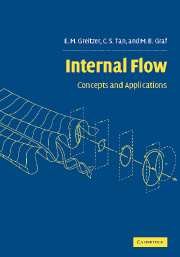Book contents
- Frontmatter
- Contents
- Preface
- Acknowledgements
- Conventions and nomenclature
- 1 Equations of motion
- 2 Some useful basic ideas
- 3 Vorticity and circulation
- 4 Boundary layers and free shear layers
- 5 Loss sources and loss accounting
- 6 Unsteady flow
- 7 Flow in rotating passages
- 8 Swirling flow
- 9 Generation of streamwise vorticity and three-dimensional flow
- 10 Compressible internal flow
- 11 Flow with heat addition
- 12 Non-uniform flow in fluid components
- References
- Supplementary references appearing in figures
- Index
12 - Non-uniform flow in fluid components
Published online by Cambridge University Press: 14 January 2010
- Frontmatter
- Contents
- Preface
- Acknowledgements
- Conventions and nomenclature
- 1 Equations of motion
- 2 Some useful basic ideas
- 3 Vorticity and circulation
- 4 Boundary layers and free shear layers
- 5 Loss sources and loss accounting
- 6 Unsteady flow
- 7 Flow in rotating passages
- 8 Swirling flow
- 9 Generation of streamwise vorticity and three-dimensional flow
- 10 Compressible internal flow
- 11 Flow with heat addition
- 12 Non-uniform flow in fluid components
- References
- Supplementary references appearing in figures
- Index
Summary
Introduction
In this chapter the discussion of fluid component and system response to disturbances, begun in Chapter 6, is extended to a broader class of flow non-uniformities. Whereas Chapter 6 considered primarily one-dimensional disturbances, that restriction is now dropped and we address more general (two- and three-dimensional) non-uniformities with variations transverse to the bulk flow direction. Examples of interest are turbomachines subjected to circumferentially varying inlet conditions and the behavior of components with geometry generated non-uniformity, such as is caused by a contraction or a bend in close proximity.
Three important issues relating to these situations can be identified. One is the effect of the fluid component on the flow non-uniformity, or distortion: how are the non-uniformities altered by passage through the component? A second is the effect of the non-uniformity on the component: how does the distortion modify the component performance? The approaches needed to address these two questions are fundamentally different. For the former, qualitative aspects, and even many quantitative features, can be resolved within the framework of a linearized description. For the latter, however, the problem is inherently nonlinear and a different level of analysis is needed. Beyond component performance there is a third issue. Because fluid components typically occur as part of an overall system, what changes in interactions with the rest of the system arise due to the non-uniformity?
Several integrating themes thread through the different applications discussed. The first is that fluid components do not passively accept non-uniform flow but play a major role in modifying the velocity distribution.
- Type
- Chapter
- Information
- Internal FlowConcepts and Applications, pp. 615 - 682Publisher: Cambridge University PressPrint publication year: 2004
- 1
- Cited by



